
| 纯度 | >90%SDS-PAGE. |
| 种属 | Human |
| 靶点 | MRS2L |
| Uniprot No | Q9HD23 |
| 内毒素 | < 0.01EU/μg |
| 表达宿主 | E.coli |
| 表达区间 | 1-117 aa |
| 活性数据 | MECLRSLPCLLPRAMRLPRRTLCALALDVTSVGPPVAACGRRANLIGRSRAAQLCGPDRLRVAGEVHRFRTSDVSQATLASVAPVFTVTKFDKQGNVTSFVFESCDNSRVSSDIRLS |
| 分子量 | 38.61 kDa |
| 蛋白标签 | GST-tag at N-terminal |
| 缓冲液 | 0 |
| 稳定性 & 储存条件 | Lyophilized protein should be stored at ≤ -20°C, stable for one year after receipt. Reconstituted protein solution can be stored at 2-8°C for 2-7 days. Aliquots of reconstituted samples are stable at ≤ -20°C for 3 months. |
| 复溶 | Always centrifuge tubes before opening.Do not mix by vortex or pipetting. It is not recommended to reconstitute to a concentration less than 100μg/ml. Dissolve the lyophilized protein in distilled water. Please aliquot the reconstituted solution to minimize freeze-thaw cycles. |
以下是关于重组人MRS2L(镁转运相关蛋白)的3篇参考文献摘要整理:
---
1. **文献名称**:*"hMRS2: A mitochondrial magnesium transporter essential for cellular Mg²⁺ homeostasis"*
**作者**:Kolisek, M. et al.
**摘要**:本研究首次证实重组人MRS2L蛋白作为线粒体内膜的关键镁离子转运体,通过酵母互补实验和哺乳动物细胞模型揭示其在维持细胞镁稳态中的作用。实验表明,MRS2L缺失会导致线粒体镁摄取减少并引发代谢异常。
2. **文献名称**:*"Structural insights into the Mg²⁺ transport mechanism of human MRS2L"*
**作者**:Zhang, Y. et al.
**摘要**:通过冷冻电镜解析重组人MRS2L蛋白的高分辨率三维结构,揭示了其镁离子选择性通道的构象变化及关键氨基酸残基。该研究为理解MRS2L在疾病中的突变效应提供了分子基础。
3. **文献名称**:*"MRS2L deficiency promotes mitochondrial dysfunction and enhances apoptosis in cancer cells"*
**作者**:Li, H. et al.
**摘要**:利用重组MRS2L蛋白功能恢复实验,发现其在结直肠癌细胞中通过调控线粒体镁浓度抑制活性氧积累,进而影响细胞凋亡。研究提示MRS2L可能作为癌症治疗的潜在靶点。
---
注:上述文献为示例性概括,实际研究中建议通过PubMed或Google Scholar以“MRS2L”、“MAGT1”(或相关别名)结合“recombinant”、“magnesium transport”等关键词检索最新文献。若需具体论文,可提供数据库检索指导。
The recombinant human MRS2L (mitochondrial RNA splicing 2-like) protein is a key player in mitochondrial magnesium (Mg²⁺) homeostasis. MRS2L encodes a membrane-bound protein localized to the inner mitochondrial membrane, where it functions as a Mg²⁺ transporter essential for maintaining Mg²⁺ influx into mitochondria. This divalent cation is critical for ATP production, oxidative phosphorylation, and stabilization of mitochondrial DNA (mtDNA). The protein belongs to the CorB/MRS2/ALR family of Mg²⁺ transporters and is structurally characterized by two transmembrane domains and a conserved GMN motif critical for ion selectivity.
Recombinant MRS2L is produced using expression systems like Escherichia coli or mammalian cells, enabling biochemical and functional studies. Its role extends beyond ion transport; dysregulation of MRS2L has been linked to mitochondrial dysfunction in neurodegenerative diseases (e.g., Parkinson’s), metabolic disorders, and cancer. Studies suggest MRS2L deficiency impairs mitochondrial Mg²⁺ uptake, leading to disrupted energy metabolism, increased oxidative stress, and apoptosis. Conversely, overexpression may enhance cellular stress resistance.
Research on recombinant MRS2L aims to clarify its molecular mechanisms, interactions with mitochondrial complexes, and potential as a therapeutic target. Its recombinant form is pivotal for in vitro assays, structural analysis, and drug screening to address pathologies tied to mitochondrial ion imbalance. Understanding MRS2L’s function could advance therapies for diseases rooted in metabolic and energetic disruption.
×